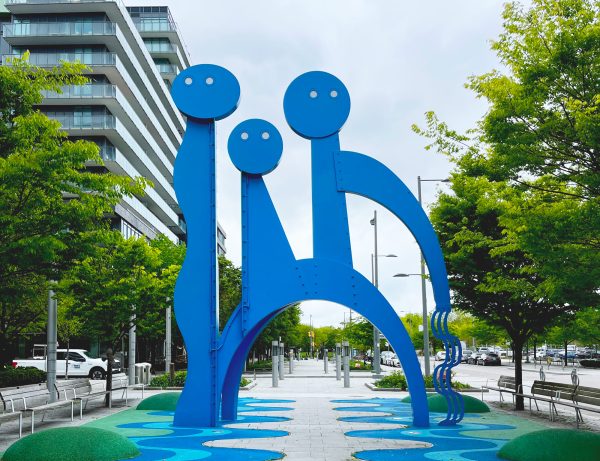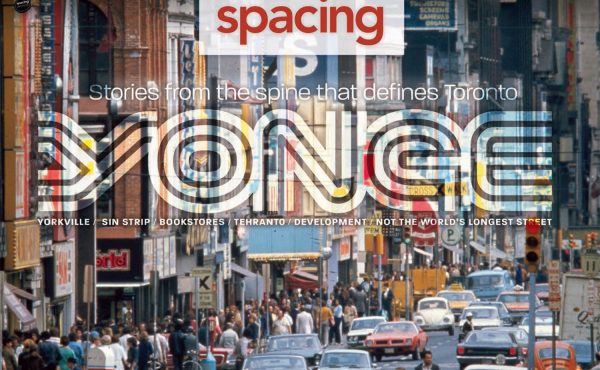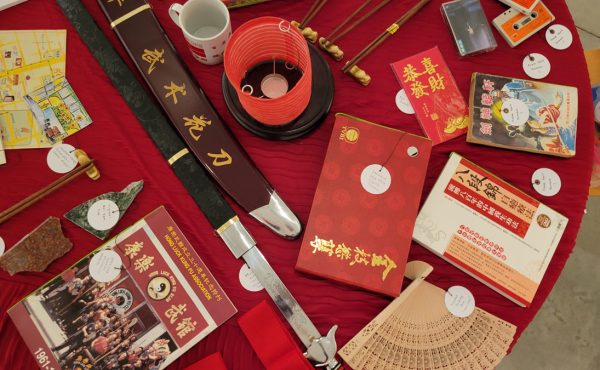This walking tour is published in conjunction with Spacing issue 71, which is focused on the waterfront. See also Sarah Mundangepfupfu’s article about public art on the waterfront in the print issue. The issue will be available shortly at the Spacing Store and other fine bookstores, and in subscribers’ mailboxes.
The West Don Lands is the first community-scale comprehensive master art plan in Canada. While the official theme of the artworks is “revealing the industrial and natural heritage of the area as we look to a sustainable future,” it’s easy to see how public art can help build a community. I learned this first hand after attending a Jane’s Walk led by Waterfront Toronto Staff. It’s refreshing and delightful to see Waterfront Toronto’s approach to public art. As you follow along this walk, you may be able to see how residents interact with the planned public spaces as well as the works of art.
We will begin and end our walk at the corner of Mill Street and Bayview Avenue. On the southern end of the intersection, you will find a large sculpture built of vermilion-painted steel and timber beams.
No Shoes by Mark di Suvero
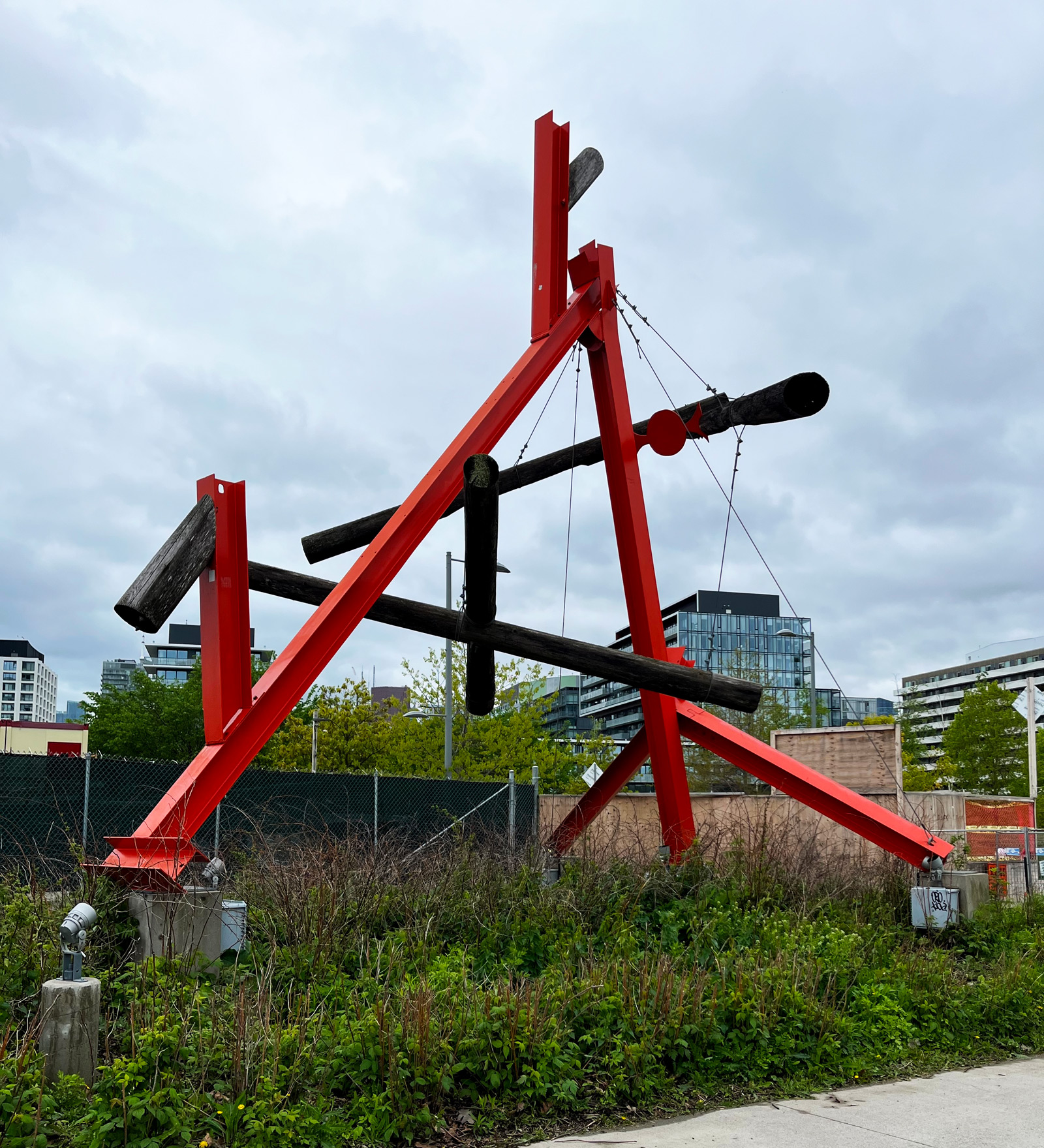
No Shoes was created relatively early in di Suvero’s career. Many regard this work as instrumental in defining the artist’s future pieces. Initially, this artwork was part of the Dominion Year celebration of ‘67. The High Park Sculpture Symposium brought together artists from around the world to establish the first sculpture park in Toronto. This was an important early step in creating what has often been described as a “urban relative of land art” and defining public art for future generations. No Shoes is one of two Mark di Suvero works in Toronto. Di Suvero is a notable anti-elitist who has demonstrated the value of accessible public art. Both No Shoes and Flower Power have been relocated from their original home in High Park. The di Suvero work Flower Power can now be found at City Place.
Walk up the hill behind you.
You will reach the top of the Corktown Common. The pavilion you see, as well as the park, was designed by architecture firm Michael Van Valkenburgh Associates, Inc. The works’ sleek lines, and steel posts bound by metal cables and timber beams, echo aspects of di Suvero’s No Shoes while defining and creating a welcoming gathering space. Michael Van Valkenburgh Associates’ planning of the pavilion and the park helps set a welcoming environment for the artworks as well as the residents.
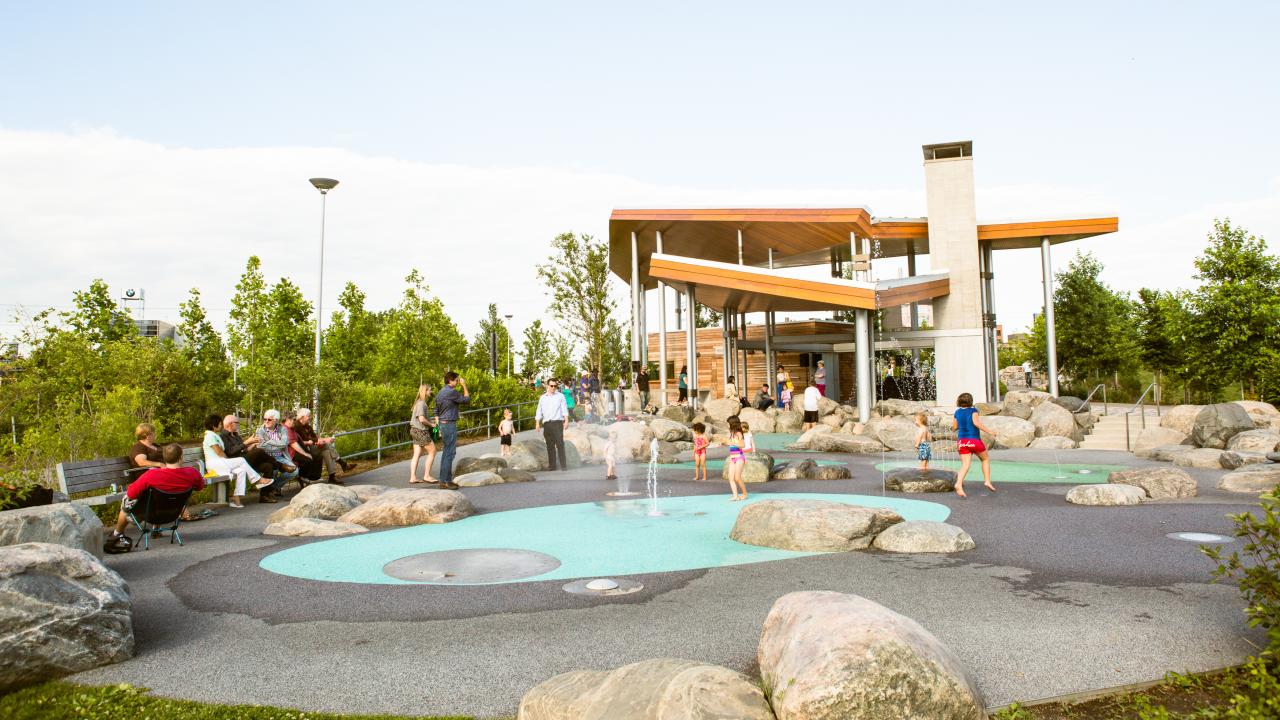
Walking down the trail to the northeast, crossing Bayview Ave, and following Lower River Street to Underpass Park, we’ll find our next work of art.
Mirage by Paul Raff
(At the time of writing, the next work, Mirage, is closed due to construction on the highway above. The work is set to reopen in early 2026. This work highlights the cohesive artwork in the neighborhood, as well as demonstrating some of the ideas behind future artworks being installed by Waterfront Toronto.)
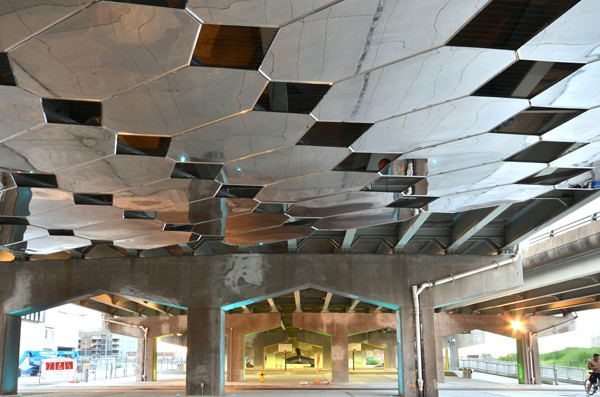
Mirage is one of the many Toronto public artworks done by Paul Raff, including Limelight Bandshell, Shoreline Commemorative, and Wavelengths. This has been labeled the most extensive park built under an overpass in Canada. This work is meant to expand the space through a playful use of reflection. The work reflects light onto spaces typically shadowed by the underpass, drawing people into the space. Waterfront Toronto plans to apply a similar approach to the Gardner underpasses. Waterfront BIA will be implementing a similar technique under the Gardner expressway as they create a series of gateways to the waterfront, transforming the dark, utilitarian, and forgotten spaces into an inviting community use space and public art installations.
Turning to the south and following Eastern Ave west will lead you to the next work of art.
Site Specific by Scott Eunson and Marianne Lovink Seal
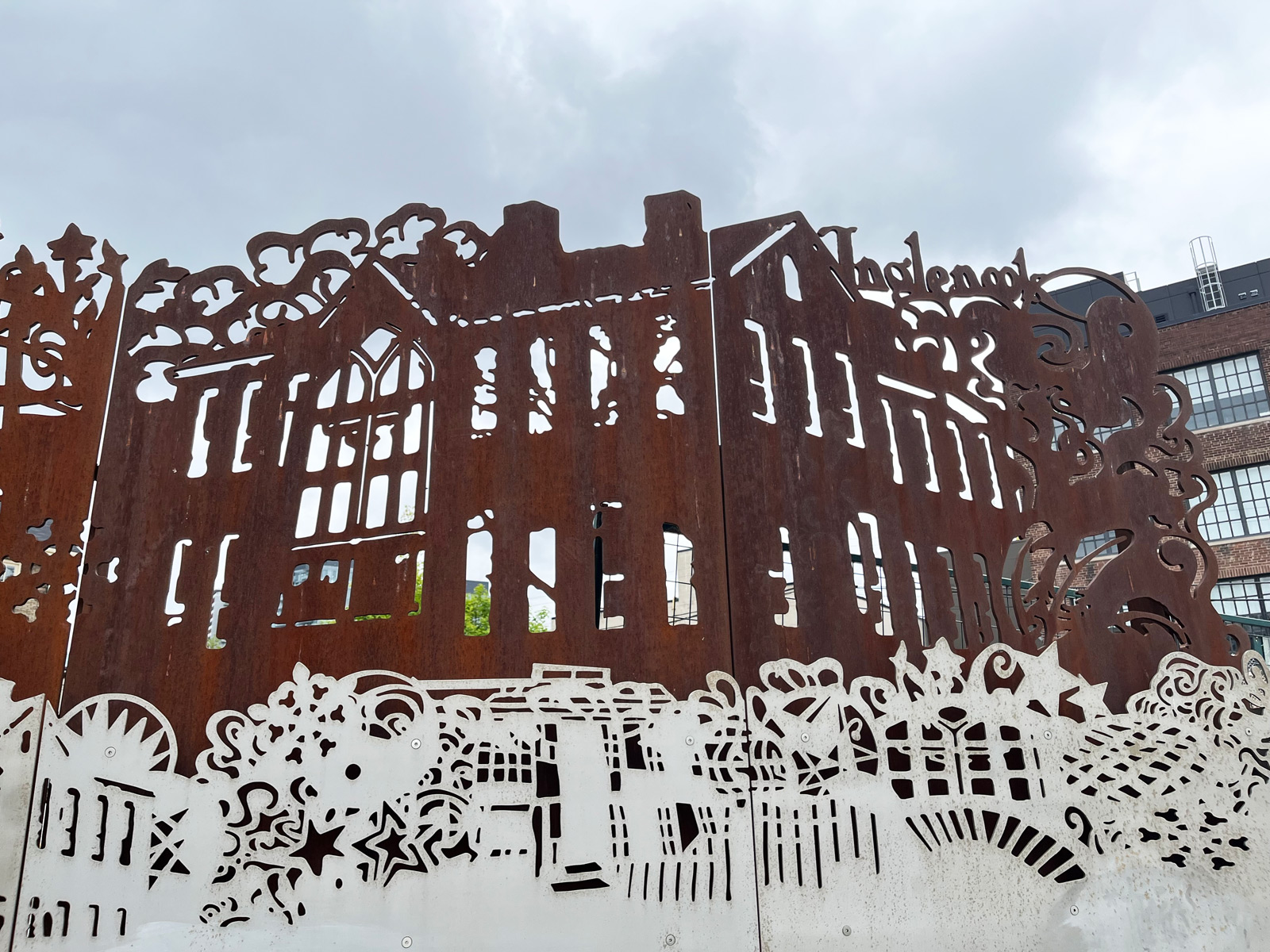
Site Specific is described by the artists as “the visual nature of the neighborhood.” This work tells the story of the residents who lived in this neighborhood, beginning with the Indigenous peoples. Starting at the intersection of Sumac Street and Eastern Ave, and walking north, you can see the faint shapes of branches of the white Pine, a revered plant and medicine within the Haudenosaunee culture. The negative space forms a large ear of corn, the woven shape of a lacrosse stick, as well as what appears to be a longhouse. Moving north, we can see the faint shape of a fleur-de-lis appear. This symbolizes the French fur trade and the mark of colonialism on both the people and the land. The work quickly changes from its organic shapes to the grid structure of a colonial city. The artists described the work as “playing specific attention to the time of Lucie and Thornton Blackburn”. The Backburns fled slavery, first settling in Michigan and then moving to Upper Canada to ensure their freedom. The carriage you see in the middle of the work may reference Blackburn’s entrepreneurship, as they started the first taxi carriage in the city. Again, the work changes quickly, and we see the city skyline changing as church steeples and Victorian row houses begin to be blocked out by high-rises. Ultimately, as you walk to the end of the work, you see the silhouette of Inglenook Community High School, symbolizing that the work has circled back to where it began. Not only did the archaeological dig on the site of the Inglenook school uncover the story of the Blackburn family home that once stood there, but students from the school also contributed to this project.
From Sight Specific, head south along Cherry Street. Passing Front Street on your left, just past the Anishnawbe Health Toronto building, you will see the next work of art.
In Equilibrium by Ludovic Boney
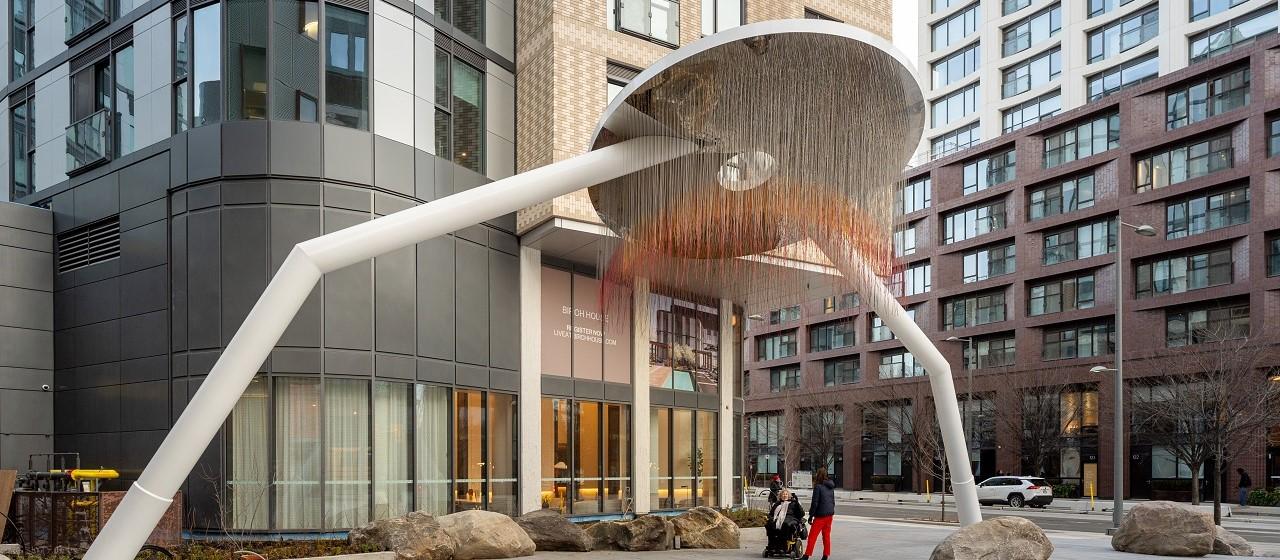
Boney is a member of the Wendat First Nation. The sculpture In Equilibrium stands nearly 28 feet high, serving as a gateway for the Indigenous hub directly to the north. The work “celebrates the importance of Indigenous placemaking and place keeping and the layers of Indigenous presence, past, present, and future in Toronto.” The hanging stems you see represent the natural landscape and sway in the wind much like cattails. The mirrored surface encourages viewers to reflect on their own relationship with the natural environment. Standing in front of the sculpture, you can hear the faint jingle of the ball chain on the building behind you. This architectural feature responds to the artwork in front of you. Often, the art we’ve seen was designed in response to the pre-existing buildings of the neighborhood. It’s unique that the architecture is created in response to a work of art. Another distinctive aspect is that this piece now belongs to Anishnawbe Health Toronto. Waterfront Toronto has transferred ownership of most public art it commissioned to the city, but this piece now belongs to Anishnawbe Health Toronto.
From here, turn back north, then turn east onto the north side of Front Street East.
Untitled (Toronto Lamp Posts) by Tadashi Kawamata
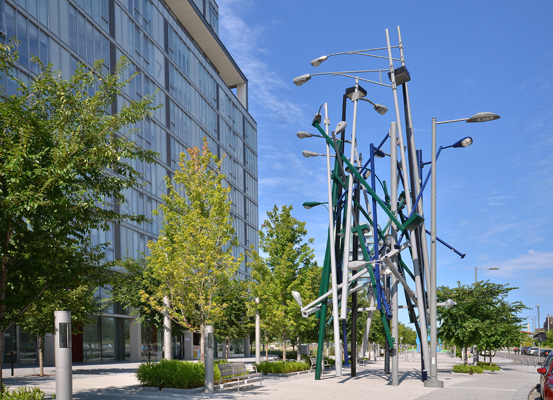
This piece is made of old lamp posts. They form an almost fort-like shape. Looking closely, you can see many of the kinds of lamp posts that have illuminated the city. The remnants of old glass street lamps are tucked into the center. Once merely broken parts, the artist salvaged pieces from the city’s maintenance department to create the artwork. Kawamata wants the viewer to ponder how the tower stands, each post supporting the next like “Mikado sticks just before they fall.” When standing in the center of the cave-like shape the artist has created, you can see echoes of each little neighborhood in the city. One can’t help but think of the memories made under each of the lamp posts. How many first kisses took place under the lights? How many street hockey games have the lamp posts illuminated, ultimately signaling it was time to end?
Continuing east on Front Street will lead you to the next work of art at Tannery Road and Front Street East.
Water Guardians by Jennifer Marman, Daniel Borins, and James Khamsi
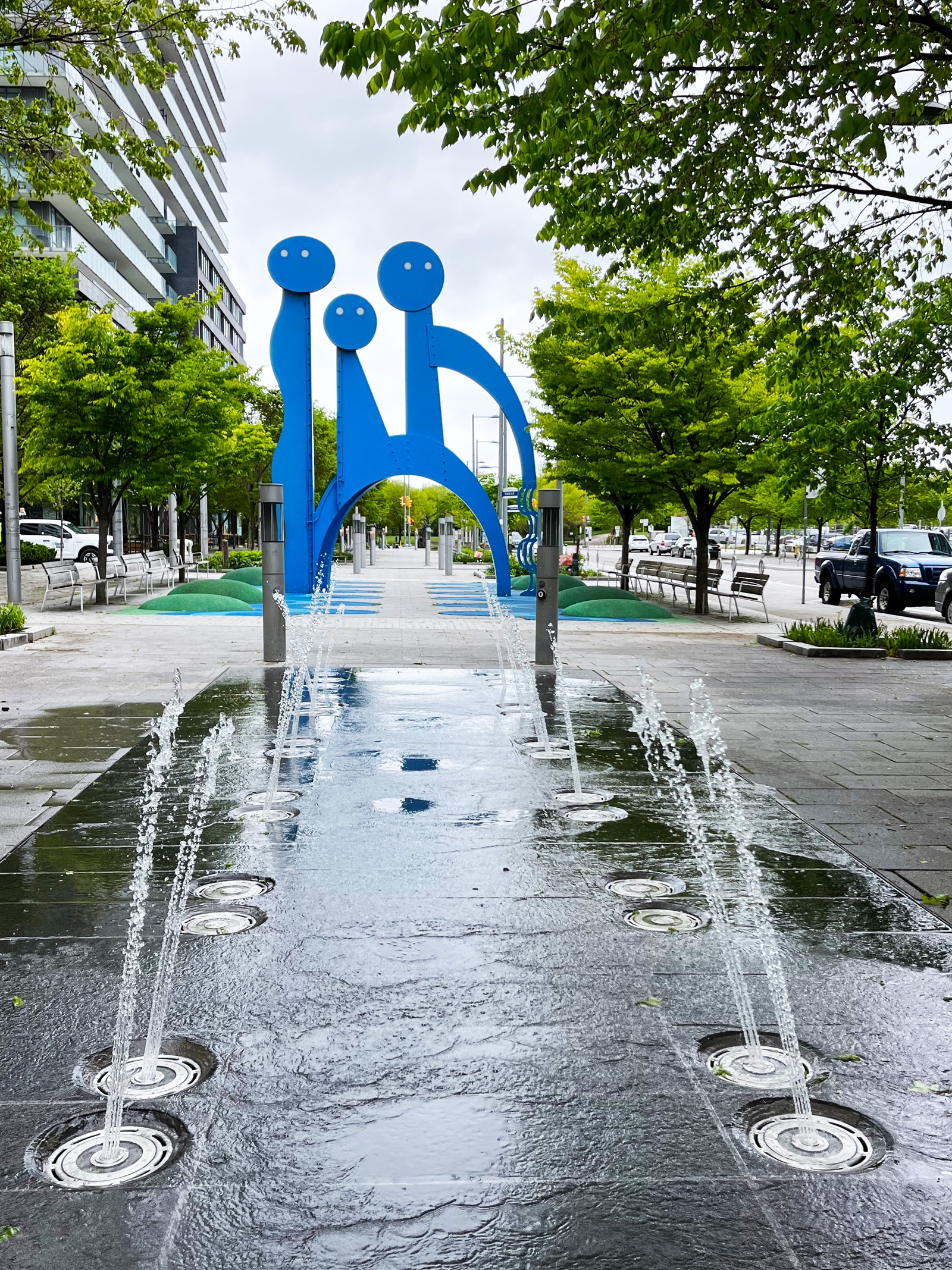
Water Guardians is built on a bouncy rubber playground surface. The three large figures transform the promenade into a play space and a work of art. The surface bumps and squiggles of blue transform the dry surface into an imaginary river ready for children and adults to explore. The eyes of the figures illuminate at night, acting as a beacon. Turning on the water feature west of the sculpture, you will see streams of water that mirror the arches the Water Guardians form. This work of art not only captures the child-like spirit and themes of guardianship over the environment that are featured in Boney’s work, but also engages children within the conversation in a playful manner.
Just east of this work, at Bayview Avenue and Front Street East, you will find an assemblage of brass sculptures.
Garden of Future Follies by Hadley & Maxwell
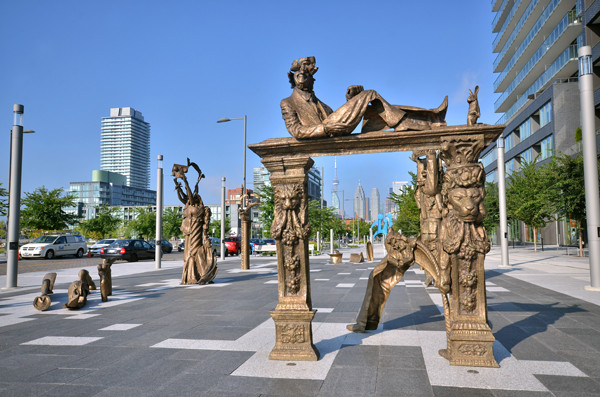
This whimsical work references many of the classic public works of art from the 19th century within Toronto. Look closely and you may be able to find the nose of Queen Victoria, the hands of a WWI soldier, or even the lions that guard a beloved library. Like many of the works selected and installed by Waterfront Toronto, this work of art helps us question the purpose of public art. Harkening to a day when most public art was meant to honor heads of state or commemorate military victories, we can see how modern the concept of public art is. Throughout history, most public art has been for governmental purposes, such as monuments and honorific statues raised out of public reach by a grand pedestal or centered on a fountain, meant to commemorate an individual or event, but very much kept away from the people. The Mark di Suvero work we started with marked a turning point in Toronto’s story of public art, and with Garden of Future Follies the artists are telling both the story of public art both pre-1960s and contemporarily. The artwork is meant to highlight this dichotomy.
Turn south onto Bayview and continue to the corner of Mill Street and Bayview Avenue.
Peeled Pavement by Jill Anholt
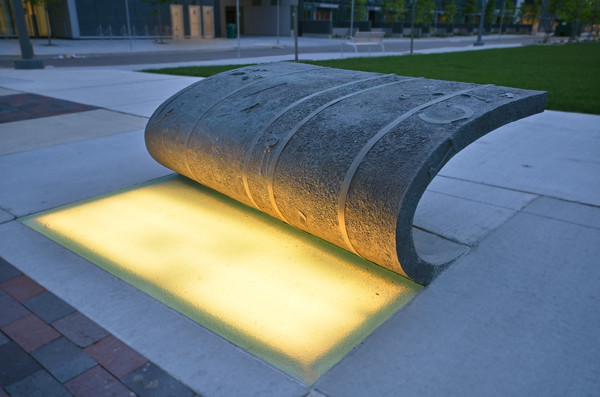
This work of concrete clad in bronze is meant to act as a peeled-away piece of sidewalk. The underside reveals the detailed past of the neighborhood. Peeled Pavement is reminiscent of the top layers of soil, like an archaeological dig. In many ways, this work reiterates aspects of the story of Site Specific in a broader sense. The pavement shows objects that are lost within the earth as time passes. The tools and screws, nuts, bolts and calipers represent the industrial past of the land. Most of this neighborhood was home to factories and slaughterhouses, including the Williams Davies company. The light shining through is meant to convert the energy of the city. The work acts as an informal sitting space.
Water Guardians and Toronto Lamp Posts light up in the evening, creating a space where kids play and parents teach their kids to ride their bikes. One retired resident told me how they moved into an apartment in the community after downsizing when they retired. They like to go down on summer evenings and watch all the families playing. They told me it reminded them of the happy memories from when their now adult children were still young kids.
While public art can be found throughout the City of Toronto, Waterfront Toronto is doing something different by selecting art that helps to build a community. This can be seen in how residents of the West Don Lands use and interact with the art. The artworks have become a cherished gathering space for neighbors of all ages to come together. Instead of being marble elevated on a pedestal or iron secluded behind a fence, these pieces break that mold; they invite the public in, creating a welcoming environment much like a community would. As a result, a community has formed around the art.

